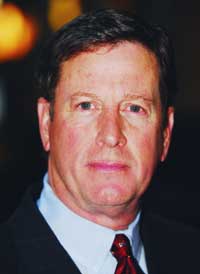Social and political returns on investments

A new study by the Center for Technology in Government describes the first steps toward measuring public return on investment. The center's methodology and its results hold great promise for agencies and governments at all levels.

Rand Blazer
Rick Steele
"Silent Cal" might say the same thing about government.
For decades, politicians, presidents and pundits have sought to make government run "more like a business," and tried to re-create Wall Street on Pennsylvania Avenue. Results have been difficult to gauge. The private sector can judge its return on investment for IT spending fairly easily, but the public sector has lacked a similar metric.
That may be changing. A new study by the Center for Technology in Government, a research arm of the State University of New York at Albany sponsored by SAP America Inc., describes the first steps toward measuring public return on investment, referred to as PROI. The center's methodology, which is nonproprietary and open to anyone interested, and its results hold great promise for agencies and governments at all levels.
Defining Public Value
The center began by expanding the definition of public value. Value, after all, is exactly what the private sector is trying to create ? value for customers, for shareholders, for employees.
In the public space, value is best defined as benefits that accrue to the public through improvements in government deriving from effective use of IT services and systems. Benefits fall into three domains:
- Political Value. The center's study asked straightforward questions in examining an IT project's political value: Does the IT project increase governmental transparency for citizens? Has IT investment improved an agency's ability to use fewer resources and gain greater credibility in reporting results to the public?
- Financial Value. Does the IT project cut government costs through new efficiencies? Does it save taxpayers money and, if so, how much?
- Social Value. Does the IT project improve quality of life by letting government enhance safety or services? Has the IT investment freed other resources for reallocation to activities directly related to citizen services? For example, will more IT spending on police services help cut crime? And finally, does the investment result in enhanced accountability and public trust in government operations?
"We believe it is absolutely possible ? and frankly, essential ? to measure the social and political impact of public-sector projects," said Anthony Cresswell, deputy director of CTG. "Public-sector organizations want to show constituents the value of the services they receive, not just that the organization itself may have saved some money."
Models of Success
The CTG study examined five public sector organizations. For the record, three of these were SAP customers. Two of the five were based in the United States. All five came to the consensus that, beyond their realization of immediate improvements in government operations, particularly in back-office practices, IT investment drove improved service to the public.
For example, the Washington State Digital Archives deployed technology to help collect data from 100 local agencies to create a digital archive. The archive is designed to preserve and, from any place and at any time, provide public access to historical public records. The move shifted the archiving responsibility to the state, freeing financial resources and creating a repository for information that the public was clamoring for.
"Our participation in this project clarified our vision and our commitment to focusing on the political and social aspects of ROI," said Adam Jansen, digital archivist, Washington State Digital Archives. "It's given us innovative ideas on how we can continue to make the public ROI case to each of our stakeholders and ensure the delivery of value to them."
Jansen is not alone. A recent survey of 776 government executives by the Economist Intelligence Unit found that 69 percent of those surveyed expect to measure both the financial and social ROI in the coming five years and to make that ROI transparent to stakeholders.
Listening and Learning
Technology vendors and public officials alike must listen carefully to taxpayers and make certain they factor stakeholder interests, and their potential effects, into any large-scale government IT proposal.
They must partner with IT to engage investments and best practices to forge new value to the public.
Failure to heed or measure the value to the public of these investments could prove disastrous, and not only in terms of money.
Rand Blazer is president of SAP Public Services Inc. based in Washington, D.C.